

This powerful and discussion-rich lesson explores the nature of US foreign policy from Lyndon B. Johnson to Jimmy Carter, focusing on whether presidential decisions were reactive or proactive during Cold War crises. It’s a teacher-led revision session that encourages deep thinking, debate, and source evaluation, with flexible elements that can be used for independent homework tasks such as essay writing or chart completion.
Students analyse key events, assess presidential intent, and engage in a lively classroom activity that involves physically placing presidents on a reactive–proactive spectrum. Post-it notes or blue tack can be used if no time to cut-out presidential images - although the visual and interactive experience really adds to depth of understanding and great discussion points. This lesson has proven to be a student favourite, sparking meaningful debate and critical analysis, without me having to even prompt, as they were arguing with each other before they placed the images.
Learning Intention:
To evaluate the extent to which US foreign policy between 1963 and 1981 was reactive or proactive, using key events, presidential decisions, and source analysis.
What’s Included:
Reactive vs. Proactive Definitions & Examples
Clear explanations with Cold War case studies (e.g. Gulf of Tonkin vs. Nixon’s China visit) to help students grasp the difference.
Source Analysis Task
Students assess a 1965 speech by LBJ using structured prompts: provenance, content, tone, and limitations. Ideal for developing AQA source skills.
President Placement Activity
Students use evidence to position LBJ, Nixon, Ford, and Carter on a reactive–proactive spectrum. This works brilliantly with printed president images - could be used as a classroom display.
Foreign Policy Overview Table
Students complete a chart linking presidents to key events, evaluating whether each was reactive or proactive, with reasoning.
Debate Prompt: Can a policy be both reactive and proactive?
Encourages higher-order thinking and nuanced understanding of Cold War diplomacy.
Why Teachers Love It:
Teacher-led with high student engagement
Encourages debate, justification, and critical thinking
Supports AQA source analysis and essay planning
Flexible for homework follow-up (e.g. writing up chart or essays)
Proven classroom success with A-Level students
Something went wrong, please try again later.
This resource hasn't been reviewed yet
To ensure quality for our reviews, only customers who have purchased this resource can review it
to let us know if it violates our terms and conditions.
Our customer service team will review your report and will be in touch.